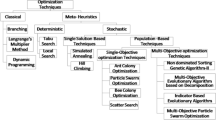Abstract
The Quadratic Assignment Problem (QAP) can be solved by linearization, where one formulates the QAP as a mixed integer linear programming (MILP) problem. On the one hand, most of these linearizations are tight, but rarely exploited within a reasonable computing time because of their size. On the other hand, Kaufman and Broeckx formulation (Eur. J. Oper. Res. 2(3):204–211, 1978) is the smallest of these linearizations, but very weak. In this paper, we analyze how the Kaufman and Broeckx formulation can be tightened to obtain better QAP-MILP formulations. As shown in our numerical experiments, these tightened formulations remain small but computationally effective to solve the QAP by means of general purpose MILP solvers.
Similar content being viewed by others
References
Adams, W. P., Guignard, M., Hahn, P. M., & Hightower, W. L. (2007). A level-2 reformulation-linearization technique bound for the quadratic assignment problem. European Journal of Operational Research, 180(3), 983–996.
Adams, W. P., & Johnson, T. A. (1994). Improved linear programming-based lower bounds for the quadratic assignment problem. In DIMACS series in discrete mathematics and theoretical computer science (Vol. 16, pp. 43–75), Providence: American Mathematical Society.
Baotic, M. (2004). Matlab interface for CPLEX, http://control.ee.ethz.ch/~hybrid/cplexint.php.
Burkard, R. E., Dell’Amico, M., & Martello, S. (2009). Assignment problems (pp. 203–304). Philadelphia: SIAM.
Burkard, R. E., Karisch, S. E., & Rendl, F. (1997). QAPLIB—a quadratic assignment problem library. Journal of Global Optimization, 10(4), 391–403. http://www.seas.upenn.edu/qaplib/.
Drezner, Z., Hahn, P. M., & Taillard, É. D. (2005). Recent advances for the quadratic assignment problem with special emphasis on instances that are difficult for meta-heuristic methods. Annals of Operations Research, 139(1), 65–94.
Eschermann, B., & Wunderlich, H. J. (1990). Optimized synthesis of self-testable finite state machines. In 20th international symposium on fault-tolerant computing (FTCS 20), Newcastle Upon Tyne, UK, June.
Fischetti, M., Monaci, M., & Salvagnin, D. (2012). Three ideas for the quadratic assignment problem. Operations Research, in press.
Gilmore, P. C. (1962). Optimal and suboptimal algorithms for the quadratic assignment problem. Journal of the Society for Industrial and Applied Mathematics, 10(2), 305–313.
Hahn, P., & Grant, T. (1998). Lower bounds for the quadratic assignment problem based upon a dual formulation. Operations Research, 46(6), 912–922.
Kaufman, L., & Broeckx, F. (1978). An algorithm for the quadratic assignment problem using Benders’ decomposition. European Journal of Operational Research, 2(3), 204–211.
Koopmans, T. C., & Beckmann, M. J. (1957). Assignment problems and the location of economic activities. Econometrica. Journal of the Econometric Society, 25(1), 53–76.
Lawler, E. L. (1963). The quadratic assignment problem. Management Science, 9(4), 586–599.
Loiola, E. M., Abreu, N. M. M., Boaventura-Netto, P. O., Hahn, P., & Querido, T. (2007). A survey for the quadratic assignment problem. European Journal of Operational Research, 176(2), 657–690.
Peng, J., Mittelmann, H., & Li, X. (2010). A new relaxation framework for quadratic assignment problems based on matrix splitting. Mathematical Programming Computation, 2(1), 59–77.
Xia, Y., & Yuan, Y. X. (2006). A new linearization method for quadratic assignment problems. Optimization Methods and Software, 21(5), 805–818.
Zhang, H. Z., Beltran-Royo, C., & Constantino, M. (2010). Effective formulation reductions for the quadratic assignment problem. Computers and Operations Research, 37(11), 2007–2016.
Zhang, H. Z., Beltran-Royo, C., & Ma, L. (2010). Solving the quadratic assignment problem by means of general purpose mixed integer linear programming solvers. http://www.optimization-online.org/DB_HTML/2010/05/2622.html, pp. 1–16.
Acknowledgements
Thanks are due to the support of the National Natural Science Foundation of China (Grant No. 70871081), and to the support from MAEC-AECID fellowship from the Spanish government. We wish to thank the Faculty of Sciences of the University of Lisbon for providing the software Cplex 11.2. We also thank the support of the grant S2009/esp-1594 from the ‘Comunidad de Madrid’ (Spain) and the grant MTM2009-14039-C06-03 from the Spanish government.
Author information
Authors and Affiliations
Corresponding author
Rights and permissions
About this article
Cite this article
Zhang, H., Beltran-Royo, C. & Ma, L. Solving the quadratic assignment problem by means of general purpose mixed integer linear programming solvers. Ann Oper Res 207, 261–278 (2013). https://doi.org/10.1007/s10479-012-1079-4
Published:
Issue Date:
DOI: https://doi.org/10.1007/s10479-012-1079-4




